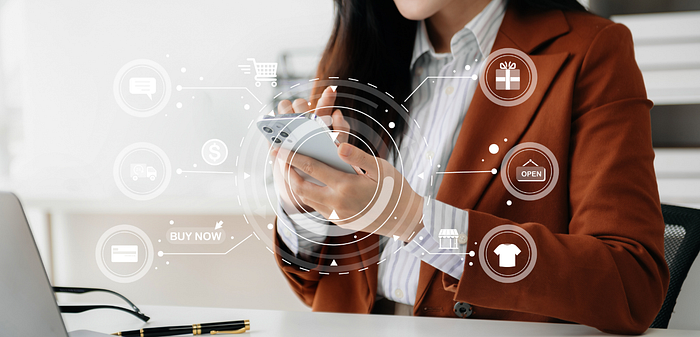Smart Moves: How Retail Strategy and Tech Are Redefining Shopping
Shopping has never been more exciting — or more complex. Whether you’re scrolling through a mobile app or wandering the aisles of your local store, your experience has been carefully designed behind the scenes. And the secret? A smart mix of retail strategy and retail technology strategy.
Retailers today must do more than just stock shelves. They need a well-thought-out plan and the right tools to serve customers in fast, flexible, and personalized ways. In this blog, we’ll break down exactly how retail businesses — large and small — can thrive by combining strategic thinking with smart technology.

What Is Retail Strategy?
Retail strategy is the master plan that guides how a business attracts customers and drives sales. It includes decisions about pricing, product selection, store location, customer service, and branding. Like building a house, every detail matters — from the foundation (your business model) to the paint on the walls (your marketing tone). A clear retail strategy gives retailers a roadmap to meet customer expectations and remain competitive.
Why a Strong Retail Strategy Matters
Without a solid retail strategy, even great products can go unnoticed. A strong plan ensures that the right products are available to the right customers at the right time. It helps businesses build loyalty, adapt to changes, and compete effectively. When strategy aligns with customer needs, everything from marketing to merchandising works more smoothly.
Real-World Examples of Great Retail Strategy
Take Target, for instance. Its mix of affordable pricing, trendy products, and user-friendly digital experience creates consistent appeal. Trader Joe’s succeeds by offering unique private-label items in a no-frills environment, encouraging discovery and value. Apple’s retail stores serve as immersive brand experiences rather than just sales points. These companies succeed not because they’re lucky, but because they have laser-focused strategies.
What Is Retail Technology Strategy?
While retail strategy lays the foundation, retail technology strategy builds the modern tools to support it. This includes systems and platforms that streamline operations, collect customer insights, and enhance the shopping experience. From inventory management software to mobile apps, retail technology is how strategy comes to life in real time.

How Technology Powers Better Retail Experiences
Let’s say you’re shopping online and the website recommends something you’ve bought before. Or you’re in a store and a self-checkout kiosk makes paying easier. These conveniences aren’t random — they’re the result of smart retail technology strategy. When used correctly, tech helps retailers anticipate customer needs, automate routine tasks, and reduce friction in the buying process. It adds speed, convenience, and personalization to what used to be simple transactions.
Popular Technologies in Today’s Retail World
Some of the most game-changing tools include:
- Artificial intelligence (AI): Predicts buying behavior and personalizes recommendations.
- Inventory management systems: Ensure stores never run out of bestsellers.
- RFID technology: Tracks products more accurately than traditional barcodes.
- Chatbots: Provide 24/7 customer support and quick answers.
- Augmented reality (AR): Lets customers visualize products before purchase.
Retailers aren’t just embracing technology — they’re relying on it to compete.
How Retail Strategy and Technology Strategy Work Together
Think of retail strategy as the vision, and retail technology strategy as the toolkit. Together, they enable a business to not only plan smart but act smarter. If a retailer’s strategy is to improve customer loyalty, technology can support it by offering personalized rewards or tracking buying habits. If the goal is faster delivery, logistics tools can optimize shipping routes and manage inventory across locations.

Small Stores, Big Wins: Local Shops Use Smart Strategy
It’s not just big names that benefit. A local bakery might use a POS system to track which items sell best and schedule email promotions for slow days. A neighborhood bookstore can manage its inventory digitally, offer online reservations, or even sell gift cards via a mobile app. These are perfect examples of how retail strategy and technology strategy can empower small businesses to punch above their weight.
The Role of Customer Data in Retail Strategy
Customer data is like gold in modern retail. Every purchase, click, or abandoned cart tells a story. When analyzed correctly, this data helps businesses decide what to stock, when to offer discounts, and how to communicate with their audience. A retail strategy backed by real insights is far more likely to succeed than one based on guesswork.
How Mobile Shopping Is Shaping Strategy
Mobile commerce is no longer just a trend — it’s the norm. Shoppers expect to browse, compare, and buy on the go. This shift forces retailers to adopt mobile-first strategies. Apps, responsive websites, and location-based services are now essential tools in the retailer’s digital playbook. For brands that get it right, mobile becomes a direct channel for engagement and sales.
Social Media and Retail Strategy
Social media platforms are not just marketing channels — they’re shopping hubs. A well-planned retail strategy uses social media for product discovery, customer service, and brand storytelling. Platforms like Instagram and TikTok also allow direct purchasing, meaning customers can see a product and buy it without leaving the app. That’s powerful stuff for retailers looking to grow.
Building a Seamless Omnichannel Experience
An omnichannel approach gives customers a consistent experience, whether they’re shopping in a store, online, or through an app. It involves integrating systems so customer data, inventory, and promotions flow between platforms. For instance, a customer could buy online, pick up in-store, and return via mail. To make this work, retailers need a clear strategy supported by the right technology — otherwise, things fall through the cracks.
Common Mistakes in Retail Strategy
Some businesses stumble by focusing too much on short-term tactics — like flash sales or trend-hopping — without thinking long-term. Others fail to train staff on new technologies, leaving customers frustrated. And perhaps the biggest mistake? Ignoring customer feedback. A successful strategy evolves with changing behaviors and expectations. Flexibility is key.
The Future of Retail Strategy and Technology
What does the road ahead look like? More automation, smarter personalization, and immersive experiences. Imagine virtual try-ons, AI-powered shopping assistants, and eco-conscious supply chains. The future of retail strategy isn’t just about what you sell — it’s about how seamlessly you can blend physical and digital experiences to create value.

Final Thoughts and Takeaways
Retail is in the midst of a transformation. But that doesn’t mean the basics have changed. Understanding your customer, offering value, and staying one step ahead remain the foundation of success.
The difference now is how you deliver on those promises. That’s where retail technology strategy shines. With the right tools in place, your strategy becomes more effective, more efficient, and more adaptable.
In short: plan smart, act smarter, and always keep the customer at the center of it all.
Frequently Asked Questions (FAQs)
1. What is a retail strategy?
A retail strategy is a business’s overall plan to attract customers and grow sales through product selection, pricing, marketing, and customer experience.
2. What does a retail technology strategy include?
It includes tools and platforms like POS systems, inventory software, and customer data analytics that help a retailer execute their business goals more effectively.
3. How do small businesses use retail strategy?
Small businesses often use a focused strategy tailored to their local market, supported by simple technologies like email marketing or mobile ordering to compete with larger brands.
4. Why is omnichannel retail important?
Omnichannel ensures that customers get a consistent shopping experience across all platforms — online, mobile, and in-store — boosting satisfaction and loyalty.
5. How is AI changing retail strategy?
AI helps retailers predict customer needs, personalize marketing, automate service, and optimize inventory — making strategies more accurate and results more scalable.
Comments
Post a Comment